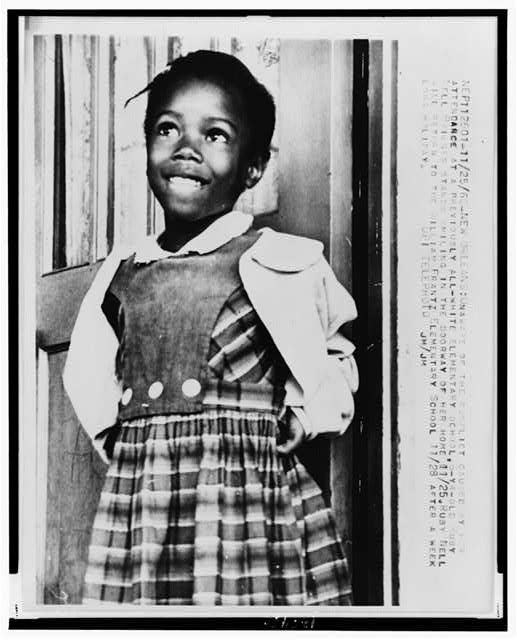 |
| Ruby as a young girl. (http://rubybridgesfacts.com/) |
Ruby Bridges was born September 8, 1954 in Tylertown, Mississippi. She was the daughter of Abon and Lucille Bridges and the oldest. She grew up on a farm where her family sharecropped. It was a hard life on the farm and her family heard there were better opportunities in the cities. At the age of four, she moved to New Orleans, Louisiana with her parents. When she got a little older it was her job to take care of her younger siblings because both her parents worked. She went to an all black school and barely ever went beyond her own block.
In 1960, when Ruby was six years old, her parents got a call from the NAACP or The National Association for the Advancement of Colored People. They volunteered Ruby to integrate into the white schools. In the spring of 1960, Ruby and other black kindergartners in the city took a test to see who would go to the white schools in September. Ruby passed the very hard test and would soon attend William Frantz Public School. Her mother was okay with it and thought it would give her a better education, but her father thought that it would cause trouble and whites and blacks would never get along. Eventually, her mother convinced her father to let Ruby go.
A federal judge decreed that November 14, 1960 would be the day the black children went to the white schools. In all six kids were chosen but two decided to stay at their old school and the other three were going to McDonough, leaving Ruby alone at William Frantz. On the 14th federal marshals drove Ruby and her mother to school. Ruby’s mother told her there maybe some people upset outside of the school and one of the marshals said four marshals would walk her and her mother, protecting them from every side. The people outside of the school were yelling and shaking their fists at them. That day her and her mother spent the whole day in the office as white parents came and took their children out of the school.
The next day when Ruby headed to school again there were still protesters. One person even had a little black girl doll in a coffin. Ruby tried to ignore everything that was going on around her. Once inside the building Ruby met her new teacher, Mrs. Henry, a young white woman with a Boston accent. She seemed nice to Ruby but she wasn’t sure considering she had never had a white teacher. When they went to her room on the second floor, all the desks were empty. She asked Ruby to pick a seat and she sat right up front. Mrs. Henry began to teach her the alphabet.
The next morning Ruby’s mother gave her some bad news. She would not be able to go to school with Ruby that day. She told her to pray to God because he would always be there for her. That was when Ruby starting using prayer as her protection. She would just ignore the crowd of screaming people and go to Mrs. Henry. She would greet Ruby with a hug and in class everyday she would sit right next to her, not in her teacher’s desk.
The riots and protests continued. Ruby’s father was fired from his job, they were told to stay away from a white grocery store, and her grandparents were told to move away from land they had sharecropped on for 25 years because of Ruby going to the white school. Only a few white families kept their children in school but none were in Ruby’s class. On the other hand, people from around the country that had heard Ruby’s story would send her letters and donations. Her neighbor even gave her dad a job painting houses. Other people would watch her house and follow behind the marshals’ car making sure no one was causing trouble. Ruby says that without the families’ friends her family couldn’t have made it. She also wouldn’t have made it without Mrs. Henry. Ruby said being with her and learning helped her forget what was going on in the world outside. Ruby couldn’t even go outside for recess. Mrs. Henry also explained why whites didn’t like integration to Ruby.
Ruby learned a lot in her year of school. She thought that the best thing she learned was that it doesn’t matter what color your skin is because God makes us all unique inside. Like, Mrs. Henry was white and she treated Ruby nice, so why could all the others have so much hate towards her? Yet, Ruby would always pray for all the people protesting outside her school every day on her way to school with the marshals. One day, Mrs. Henry thought she saw Ruby talking to the crowd when she was walking into school. Ruby was really praying because she had forgotten to in the car. Mrs. Henry told her she thought she was a very special person. She also had a child psychiatrist come and talk to her.
Ruby finished grade school at William Frantz and finished high school at an integrated high school. She went to business school and studied tourism and travel. For 15 years she worked as a travel agent until she eventually got married and began raising her sons in the city where she grew up. She began volunteering at William Frantz and began working as a liaison there. She was right back into her past. Ruby’s psychiatrist had published a book about her and everyone wanted to learn more about her. She eventually was reunited with Mrs. Henry. Ever since they met again they have stayed in communication with each other. Now Ruby goes to schools around the country and talks about racism. She is an inspiration to students around the entire country.
Page created on 3/1/2011 12:00:00 AM
Last edited 3/1/2011 12:00:00 AM
